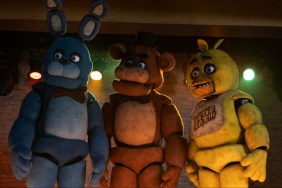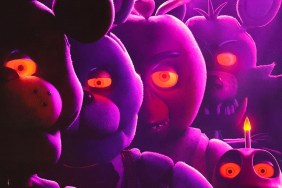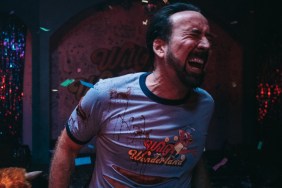
Oh look, its a lovely spider and its eating a butterfly!
That line a Truman Capote gem gleefully illustrates that all is not well with the children of Bly House in the 1961 classic, The Innocents. But we already knew something was off, thanks to director of photography Freddie Francis.
The British cinematographer would go on to helm a number of horror films and thrillers for genre stalwarts Hammer and Amicus, but The Innocents, his first foray into the horror genre, would become the career-defining masterpiece that many still remember him by. Look closer at his body of work, though, and youll see thats it just one of many gems he left for us to savor.
A child mesmerized by a spiders attack as her guardian watches on in horror all shown in incredible detail is just one of many moments in The Innocents that Francis brought to life with smart composition, deep focus and bold lighting. The use of deep focus and, at times, a split dioptor (a half lens used on top of another lens which allows both background and foreground to remain in sharp focus) lends The Innocents a surreal quality, where clarity and confusion intertwine.

As the ghosts that haunt Deborah Kerrs Miss Giddens slowly begin to turn the screw on her, they burn a black hole as sharp as a migraine onto the screen and into her sanity: A figure drifts toward a window and leers through it, grinning and lingering, with very little sound needed to emphasize just how terrifying the image is; a motionless, black-clad figure sits and observes the observer, at once both foreign and in perfect harmony with the surrounding, manicured landscape.
If these moments have a painterly quality to them, its because, on top of creating his own lenses for the production, Francis went ahead and actually painted silver leaves onto the trees of the Shepperton garden set, this gave the garden scenes a “supernatural look in daylight.”

Francis had already mastered the art of crisp monochrome photography with 1960s Saturday Night and Sunday Morning and Sons and Lovers (for which he won an Oscar), and was making a name for himself in the industry as a no-nonsense craftsman with a unique style. Film critics noticed, too; Pauline Kael wrote, I dont know where this cinematographer Freddie Francis sprang from. You may recall that in the last year just about every time a British movie is something to look at, it turns out to be his . . . in each case with a different director.
Strange, then, that at the height of his success he decided to move on from cinematography. As recognized and sought-after as Francis was becoming as a director of photography, 1961 the year he shot The Innocents was to mark the end of at least one stage of his cinematography career. He photographed Night Must Fall in 1964, but after The Innocents Freddie Francis traded in his light meter for a directors chair. It wasnt long before he found a niche for himself, directing genre fare for Hammer, Amicus and, later, Tyburn.
In 1963, he directed Paranoiac, which marked the start of a loose trilogy of psychological thrillers Francis would direct for Hammer (1964s Nightmare and 1965s Hysteria followed). Paranoiac is a gothic romance of sorts a return to the manor born for a long-lost sibling to a family surrounded by a crumbling mansion and a crumbling secret. It features a remarkable performance by Oliver Reed, who literally chews the scenery up from under his fellow actors, and his staccato, madcap delivery is something to behold. But its Francis, as the films director, who truly shines, especially in the choreography of the ever changing blocking and camerawork. His actors and camera are in a dance and not a beat is missed; its incredible stuff, and watching it, one is reminded of the power of the humble, single shot moving from over-the-shoulder to close-up to wide and back again. Making it look this on-point must have taken a lot of effort.

Francis went on to direct sequels to Hammer classics, including The Evil of Frankenstein and Dracula has Risen from the Grave, as well as underappreciated anthology horror films Torture Garden and Dr. Terrors House of Horrors. After making a lot of gothic horror in the 60s, Francis took a chance with something a little more psychedelic once the 70s hit; Mumsy, Nanny, Sonny and Girly, which predates the twisted bad taste of John Waters and Paul Bartel, is a loosely filmed and hugely entertaining slice of debauchery about a group of demented aristocrats so far removed from everyday life, that murder and torture come as natural to them as beans on toast. That same year, he directed Trog, a missing-link horror that, even though it was considered a complete embarrassment by all involved, history has been kind to. As the 70s rolled on, he directed more atmospheric horror, at times not worrying too much about the lack of a script, which seems to be the case with The Ghoul, a movie that, for the most part, is a marvelously atmospheric drive though a foggy British countryside in vintage automobiles.
By the late 70s, perhaps driven by the subpar projects he was now being offered to direct, Francis was eager to get back to cinematography. So much so, that when young American director David Lynch (a huge fan of Sons and Lovers) came calling with The Elephant Man, Francis jumped at the opportunity. In more ways than one, The Elephant Man was the triumphant return of the cinematographer in Freddie Francis. Its a bold, crisp movie that benefits from all the style and simmering mood he was developing in the 60s, and its a movie that looks like it was made back-to-back with The Innocents. Its as if his sixteen years away from cinematography merely kept his talent on ice, ready for the next project.

His work with Lynch was the begging of a renaissance for Francis, and it led to his collaborations with Scorsese on Cape Fear a movie that gleefully uses Franciss entire box of tricks and Edward Zwick on Glory, which won Francis his second Oscar. He went on to work with Lynch on two more movies; he brought a shadowy, noir mystery to Dune, and with The Straight Story, his final project, he stripped the visual vocabulary down to the bone and delivered a heartfelt and very humble look at America.
This third and final chapter in the career of Freddie Francis is something to treasure. Whether or not his work as a cinematographer was bolstered by his time as director is up to the viewer to decide, but one thing is for sure: When he decided to get back behind the camera, he came back without skipping a beat.
Francis passed away in March of 2007, leaving us a treasure trove of imagery. Whatever he was doing, whenever he was doing it, Freddie Francis always left us something to look at.
—
Glenn McQuaid is the director of I Sell the Dead and co-creator of Glass Eye Pix’s horror radio play series, Tales From Beyond the Pale.








